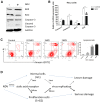Newcastle disease virus selectively infects dividing cells and promotes viral proliferation
- PMID: 30999941
- PMCID: PMC6472075
- DOI: 10.1186/s13567-019-0644-0
Newcastle disease virus selectively infects dividing cells and promotes viral proliferation
Abstract
Newcastle disease virus (NDV) can select cells to infect, but the mechanism of its cell selectivity has not been comprehensively investigated. Here, we use HeLa cells to establish that NDV can selectively infect cells at the single-cell level. We labeled proliferating cells with 5'-bromo-2-deoxyuridine (BrdU) and examined the colocalization of BrdU with NDV in cells to clarify the relationships between NDV infection and cell proliferation. Receptors at the plasma membrane mediate NDV entry into host cells. We labeled sialic acid receptor isoforms, compared their densities between different cell types and measured the sialic acid receptor densities in different cell phases. Our results suggest that NDV displays host tropism to HeLa cells compared to BHK cells and that the differences in the receptor isoform expression patterns between cell types contribute to the selection of HeLa by NDV. At the single-cell level, the dynamics of receptor expression changes during different cell phases contributing to the selection of cells in S/G2 phase for NDV infection. Furthermore, cell proliferation benefits viral replication, and enhanced virus replication leads to increased damage to cells. The elucidation of the mechanisms underlying host cell selection by NDV may help in the screening and characterizing of additional candidate oncolytic virus strains.
Figures






Similar articles
-
α2,3- and α2,6-linked sialic acids are important for cell binding and replication of Newcastle disease virus in chicken primary neuronal cells.Acta Virol. 2018;62(3):235-245. doi: 10.4149/av_2018_217. Acta Virol. 2018. PMID: 30160139
-
Enhanced Replication of Virulent Newcastle Disease Virus in Chicken Macrophages Is due to Polarized Activation of Cells by Inhibition of TLR7.Front Immunol. 2018 Apr 4;9:366. doi: 10.3389/fimmu.2018.00366. eCollection 2018. Front Immunol. 2018. PMID: 29670609 Free PMC article.
-
Newcastle Disease Virus V Protein Promotes Viral Replication in HeLa Cells through the Activation of MEK/ERK Signaling.Viruses. 2018 Sep 12;10(9):489. doi: 10.3390/v10090489. Viruses. 2018. PMID: 30213106 Free PMC article.
-
Immune responses of poultry to Newcastle disease virus.Dev Comp Immunol. 2013 Nov;41(3):447-53. doi: 10.1016/j.dci.2013.04.012. Epub 2013 Apr 25. Dev Comp Immunol. 2013. PMID: 23623955 Review.
-
Entry of Newcastle disease virus into host cells: an interplay among viral and host factors.Arch Virol. 2024 Oct 21;169(11):227. doi: 10.1007/s00705-024-06157-6. Arch Virol. 2024. PMID: 39428451 Review.
Cited by
-
Pathologic Mechanisms of the Newcastle Disease Virus.Viruses. 2023 Mar 28;15(4):864. doi: 10.3390/v15040864. Viruses. 2023. PMID: 37112843 Free PMC article. Review.
-
Therapeutic potential of oncolytic viruses in the era of precision oncology.Biomater Transl. 2023 Jun 28;4(2):67-84. doi: 10.12336/biomatertransl.2023.02.003. eCollection 2023. Biomater Transl. 2023. PMID: 38283919 Free PMC article. Review.
-
Antimetastatic and antitumor activities of oncolytic NDV AMHA1 in a 3D culture model of breast cancer.Front Mol Biosci. 2024 Aug 30;11:1331369. doi: 10.3389/fmolb.2024.1331369. eCollection 2024. Front Mol Biosci. 2024. PMID: 39281317 Free PMC article.
-
Encoding of a transgene in-frame with a Newcastle disease virus protein increases transgene expression and stability.J Gen Virol. 2022 Jun;103(6):001761. doi: 10.1099/jgv.0.001761. J Gen Virol. 2022. PMID: 35758932 Free PMC article.
-
The V protein in oncolytic Newcastle disease virus promotes HepG2 hepatoma cell proliferation at the single-cell level.BMC Cancer. 2023 Apr 17;23(1):346. doi: 10.1186/s12885-023-10815-4. BMC Cancer. 2023. PMID: 37069523 Free PMC article.
References
-
- Ravindra PV, Tiwari AK, Sharma B, Chauhan RS. Newcastle disease virus as an oncolytic agent. Indian J Med Res. 2009;130:507–513. - PubMed
MeSH terms
Grants and funding
LinkOut - more resources
Full Text Sources

